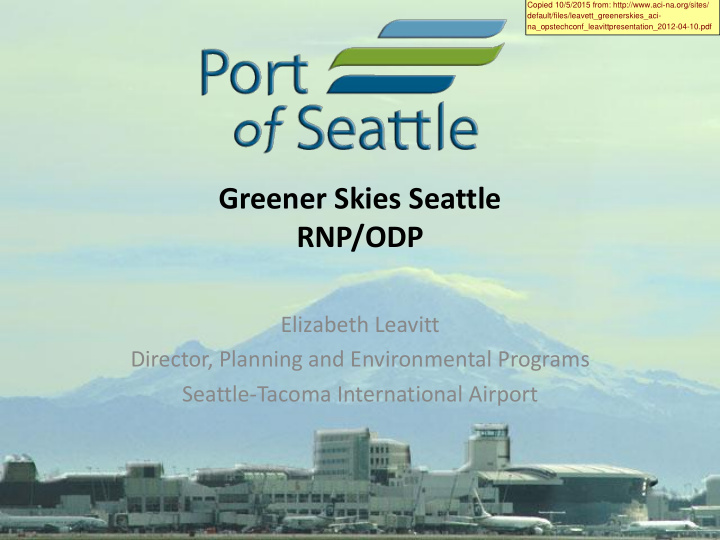



Copied 10/5/2015 from: http://www.aci-na.org/sites/ default/files/leavett_greenerskies_aci- na_opstechconf_leavittpresentation_2012-04-10.pdf Greener Skies Seattle RNP/ODP Elizabeth Leavitt Director, Planning and Environmental Programs Seattle-Tacoma International Airport
Presentation Outline • Greener Skies Overview and Benefits • Stakeholder Engagement • Implementation and the Process • Environmental Review and Community Outreach • Lessons Learned • Looking Forward
Greener Skies Overview Integrating NextGen at SEA • RNAV approaches have been published and used at SEA for many years • Greener Skies changes and improves upon the existing RNAV procedures and implements the RNP component as well as an Optimized Decent Profile (ODP)
Goals and Objectives • Reduce track mileage to minimum • Optimized Descent Profile • Absorb delays at cruise • Reduce low altitude radar vectoring • Reduce fuel burn • Identify and implement the tools, technologies and practices that enable achievement of these goals
Greener Skies Participants • Port of Seattle • NATCA • Alaska Airlines/Horizon • Boeing Field Airport • The Boeing Company • Hughes Aerospace • Jeppesen • FAA • Delta Airlines • NBAA • Southwest Airlines • HMMH
Why Seattle? • A fit, willing and able local lead carrier (Alaska/Horizon), and a committed airport operator (Port of Seattle) • A complex, but not saturated, airspace, a good environment to demonstrate the wide range of NextGen capabilities • High existing equipage of operators, over 80%, , and easier transition with remaining legacy equipment operators
Why Seattle ( Con’t ) • Intense local, Congressional, and Administrator support. (Sen. Murray, Chair Senate Transportation Appropriations, Sen. Cantwell, Chair, Aviation Operations) • Excellent facility Bargaining Unit rapport and between facilities and procedure designers. • Highest possibility of success in a single market, and thus to "bootstrap" NextGen in a wider venue.
Greener Skies Benefits • More efficient use of airspace and arrival route placement • More consistent flight paths • Reduction in both pilot and controller workload • Reduction in the number of required radio transmissions • Cost savings and environmental benefits through reduced fuel burn • Fewer residential communities overflown
Quantifiable Annual Benefits • 4,800 less flight hours – $20.4M savings • 2.9M gallons less fuel used – $7.3M savings • 30,500 metric tons less CO2 emissions – equivalent to removing 5,600 cars annually from the Seattle region
Greener Skies History 2008 - Noise initiative between SEA and Alaska Airlines - Boeing joins team as technical lead 2008 – 2010 - Projects gains high political support 2009 – 2010 - Alaska Airlines conducts 3 nighttime demonstrations with FAA, SEA, and Boeing officials onboard 2010 - FAA assumes project lead, breaks into two initiatives; i1 and i2 Today - SEA and Alaska remain active participants on project team - SEA hosting monthly team meetings
Greener Skies Initiatives Initiative 1 (i1) • STARs and RNP/RNAV approaches • Flight Simulation Trial Results (Alaska Airlines/Boeing) • Environmental Assessment • Flight Demonstrations (3) Initiative 2 (i2) • Boeing is lead for FAA • “RNP Established” • Concurrent Approaches SEA / BFI
The Process FAA’s 18 Step Process 1. Kickoff Meeting 10. Environmental Review 2. Adapt TARGETS 11. Advise Industry of Proj. Development 3. Reserve Waypoint Names 12. AVN Flight Check 4. Design the Procedure 13. Video Maps 5. Simulator Evaluation 14. Training and Notification 6. Working Group Review of Procedure 15. Process Verification 7. Process Decision 16. Lead Operator Flight Trials 8. Procedure Documentation 17. Publish Procedure for Public Use 9. Automation 18. Publish Procedure Implementation Analysis
Environmental Review FAA conducting Environmental Assessment (EA) Public Outreach • Two public scoping meetings • One agency scoping meetings Flight trials • 180 day CatX Record of Decision • 4 th Quarter 2012 Greener Skies Environmental Assessment Website www.greenerskiesea.com
Lessons Learned • FAA leadership and commitment is critical • Engage the industry, major airlines, and all other airlines • Clearly define scope, goals and timeline (early definition) • Obtain local support, i.e. communities, nearby airports, and political figures • Show the benefit, i.e. economic, social, and environmental • The process takes time…
Looking Forward • FAA Plans for next airports? • Know whether your airport benefit • Know how the community might respond • FAA or Airline lead on development of the procedures? • Environmental Assessment or CatEx required?
Recommend
More recommend